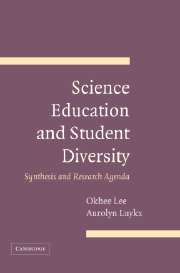Book contents
- Frontmatter
- Contents
- Foreword by Roland G. Tharp
- Acknowledgments
- Introduction
- SECTION I CONCEPTUAL GROUNDING AND POLICY CONTEXT
- SECTION II STUDENT LEARNING AND CLASSROOM PRACTICES
- SECTION III CREATING EQUITABLE LEARNING ENVIRONMENTS
- SECTION IV CONCLUSIONS AND A RESEARCH AGENDA
- Appendix: Method for Research Synthesis
- References
- Index
- References
References
Published online by Cambridge University Press: 04 December 2009
- Frontmatter
- Contents
- Foreword by Roland G. Tharp
- Acknowledgments
- Introduction
- SECTION I CONCEPTUAL GROUNDING AND POLICY CONTEXT
- SECTION II STUDENT LEARNING AND CLASSROOM PRACTICES
- SECTION III CREATING EQUITABLE LEARNING ENVIRONMENTS
- SECTION IV CONCLUSIONS AND A RESEARCH AGENDA
- Appendix: Method for Research Synthesis
- References
- Index
- References
- Type
- Chapter
- Information
- Science Education and Student DiversitySynthesis and Research Agenda, pp. 167 - 188Publisher: Cambridge University PressPrint publication year: 2006



